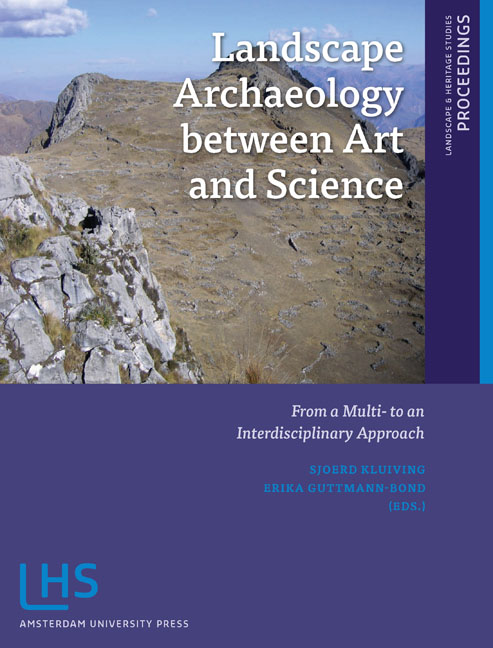Book contents
- Frontmatter
- Contents
- Preface
- Introduction: LAC2010: First International Landscape Archaeology Conference
- THEME 1 HOW DID LANDSCAPE CHANGE?
- THEME II IMPROVING TEMPORAL, CHRONOLOGICAL AND TRANSFORMATIONAL FRAMEWORKS
- THEME III LINKING LANDSCAPES OF LOWLANDS TO MOUNTAINOUS AREAS
- THEME IV APPLYING CONCEPTS OF SCALE
- THEME V NEW DIRECTIONS IN DIGITAL PROSPECTION AND MODELLING TECHNIQUES
- THEME VI HOW WILL LANDSCAPE ARCHAEOLOGY DEVELOP IN THE FUTURE?
- Miscellaneous Endmatter
5.1 - Biting off more than we can chew? The Current and Future role of Digital Techniques in Landscape Archaeology
Published online by Cambridge University Press: 21 January 2021
- Frontmatter
- Contents
- Preface
- Introduction: LAC2010: First International Landscape Archaeology Conference
- THEME 1 HOW DID LANDSCAPE CHANGE?
- THEME II IMPROVING TEMPORAL, CHRONOLOGICAL AND TRANSFORMATIONAL FRAMEWORKS
- THEME III LINKING LANDSCAPES OF LOWLANDS TO MOUNTAINOUS AREAS
- THEME IV APPLYING CONCEPTS OF SCALE
- THEME V NEW DIRECTIONS IN DIGITAL PROSPECTION AND MODELLING TECHNIQUES
- THEME VI HOW WILL LANDSCAPE ARCHAEOLOGY DEVELOP IN THE FUTURE?
- Miscellaneous Endmatter
Summary
ABSTRACT
In this paper, a broad overview is given of the recent development of digital techniques in landscape archaeology, and of the way in which these have effectively revolutionised the way in which we do landscape archaeology nowadays. Within this development, a number of fields can be identified where computer techniques are highly successful in producing better scientific results more efficiently. The main contribution of computer techniques to landscape archaeology is found in their application to the prediction and detection of archaeological remains, to exploratory data analysis and to the visualisation of research results. A number of examples are shown illustrating this. The paper also tries to address the more fundamental issue if the application of digital methods and techniques is actually helpful for developing new interpretations and theory. It is concluded that we are still facing some stiff challenges there that are closely related to the attitude of archaeology as a science to theory, but also to the difficulties of developing software tools that actually do what we need them to do.
KEY WORDS
digital techniques, landscape archaeology, archaeological theory
INTRODUCTION: THE DIGITAL REVOLUTION IN LANDSCAPE ARCHAEOLOGY
For those not so closely involved in the development of digital techniques within and outside (landscape) archaeology, it may not always be appreciated how quickly the digital world is changing. A short look at the amount and variety of software tools available for landscape archaeologists nowadays shows the speed at which these processes move. Freeware and open source packages like Python, Meshlab, Land- Serf, Depthmap, gvsig, Google Sketchup, Whitebox gat , NetLogo, R and GeoDa may all be used for specific tasks that are of interest to (landscape) archaeologists. This list is far from exhaustive; and yet, almost all of these packages were either not available ten years ago, or have gone through significant modification and development. And more significantly: there will be very few landscape archaeologists who have used all of them, or even know what they can be used for. We are now far removed from the days when an archaeological ‘computer specialist’ could be relied on to be proficient in all the computer skills necessary for archaeological research.
- Type
- Chapter
- Information
- Landscape Archaeology between Art and ScienceFrom a Multi- to an Interdisciplinary Approach, pp. 309 - 320Publisher: Amsterdam University PressPrint publication year: 2012
- 1
- Cited by



